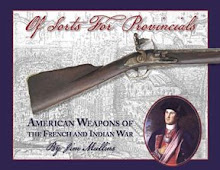Cunne Shote by Parsons ca.1762
Aside from the leggings covered earlier, another interesting culture crossing commodity that shows up with our 18th century back country kit is the butcher or scalping knife. Some of these men were carrying imported cheap fixed blade knifes that seem to have mirrored what was commonly sold for the Indian trade, sometimes referred to as"Scalping" knives or "Butcher" knives. The line between a domestic kitchen and trade items may have been very blurry in this instance.
A wide variety of handles can be found in period documents including wooden ( frequently oval or faceted and in 'yellow' woods like box, 'red' such as cam or barwood and etc.) and bone. Prices ranged a bit depending on which material was used.
Kent's Susquehanna's Indians has a nifty (early) PA estate inventory from Martin Chartier's (d 1718) store [p 63 of Kent and Logan Papers X: 110 Hist Soc of PA printed in Lancaster Co HS papers XXXIX (10) 130-33, 1925] that includes :
...To 10 Box handled knives at 6d...
...To 9 dutch Knives @ 5d...
...To 5 bone handd Knives @ 6d...
The Papers of Henry Laurens contain another box handled knife reference specific to Butcher knives:
"3 doz. & 10 Clasp knives, 3 doz. box handles Butcher knives, 3 1/2 doz. Split bone handle do...6 doz Buck Spring Knives, 4 doz & a Small do. 2 doz. buck handle Knives, 2 Blades, 5 dozen Inlaid Small Knives, 2 Doz & 3 Black handle ditto, 13 Ivory Handle pen knives[p378] 1 doz. Large Buffler knives..."
(Sept 12, 1747- Sept. 11, 1746-Oct. 31, 1755 page 376 [Appendix] Inventory of John Lauren's Estate )
“Account of all the merchandize &c. Debits & other property belonging to the Co partnership of Taylor & Duffin. Niagara, 27th. May, 1779.”
[Page F.]
"__________________________________________________[Sterling__[Total]
35 dozen + Eight Red Wood handled Scalping Knives_____3/-_____5 “ 7 -
7 dozen Camwood_____________________ditto_____________3/6_____1 “ 4 “ 6
4 1/2 dozen buck Handled____________ditto_____________3/9_____- “ 16 “ 10 1/2...”
Public Archives of Canada. MG 23 H I I 2.
This trend continued some time
"Memorandum of articles wanted to make up an assortment of presents to the Indians expected at the head of the river St. Mary's,' in Georgia, November, 1792...
'Fifty dozen knives, commonly called scalping knives: those made in the size and shape of carving knives are best, and if bone handles, more acceptable."
[Citing "State Papers, Ind., I, 312." p. 37."Tennessee Historical Magazine" St. George L. Sioussat, editor. Volume I. Tennessee Historical Society. Nashville, 1915.Google Books.]
Most of the butcher and scalping knives seem to have had a 7 inch or so up-swept tip like the knife shown above. A mixed bag of dug examples can be seen here at Grand Portage National Monument.
A similar blade shape can be seen in some English domestic scenes such as
A Fishmonger by Sandby (London ca 1759)
and this painting of John Slack, Park Keeper of Lyme (by Joseph Watson, Ca. 1750)
For a few references:
An accurate and interesting account of the hardships and sufferings of that band of heroes : who traversed the wilderness in the campaign against Quebec in 1775
By John Joseph Henry
"http://archive.org/details/cihm_35679
"The principal distinction between us, was in our dialects, our arms, and our dress. Each man of the three companies, bore a rifle-barreled gun, a tomehawk, or small axe, and a long knife, usually called a "scalping-knife," which served for all purposes, in the woods. His under-dress, by no means in a military style, was covered by a deep ash colored hunting-shirt, leggins and mockasins, if the latter could be procured. It was the silly fashion of those times, for riflemen to ape the manners of savages."
A tour in the United States of America
J.F.D. Smyth
http://catalog.hathitrust.org/Record/009714359
“They wore fringed hunting shirts, dyed yellow, brown, white and even red; quaintly carved shot-bags and powder-horns hung from their broad ornamented belts; they had fur caps or soft hats, moccasins, and coarse woolen leggings reaching half-way up to the thigh. Each carried his flintlock, his tomahawk, and scalping knife.”
A typical example excavated near Fort Haldimand, N.Y.from Historical Image bank
On the extremely cheapo end of the scale, some folks have been reworking older butcher knifes to fit this profile, others have turned to reworking the "kitchen knives" sold by Avalon Forge (I suggest sanding the red paint off and making sure the blade isn't stainless steel as these vary quite a bit!):
http://www.avalonforge.com/MainCookEat.htm
Another option is to commission a reproduction to spec, and I have gone that route with Ken Hamilton (shown in the picture below). Several others are also offering these, but I haven't tried them out yet.
I am once again indebted to fellow obsessive researcher Steve Rayner who generously provided a good portion of the leads and citations in this and many other posts!




